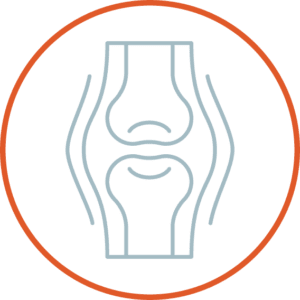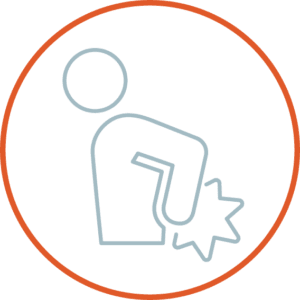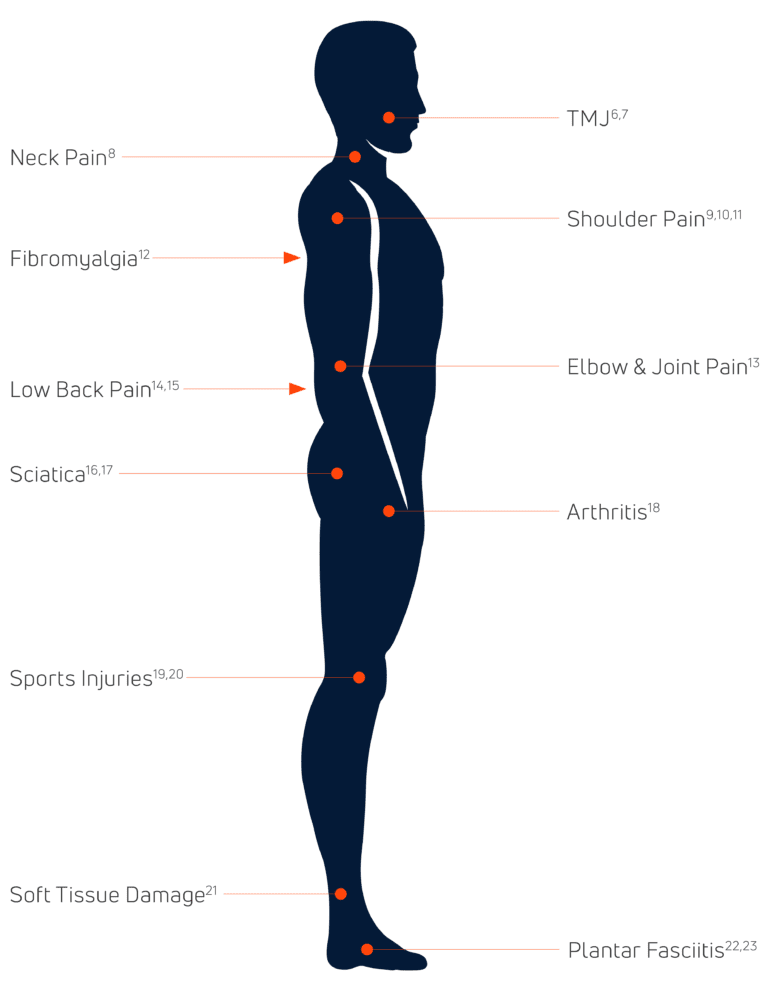
LEARN ABOUT LASER THERAPY

• What is Laser Therapy?
• The Science Behind Laser Therapy
• Class IIIb vs Class IV Laser Therapy
• Treatment Solutions
• Clinical Indications
• The LightForce Therapy Laser Range
• Request a Quote
• FAQs
WHAT IS LASER THERAPY?
Laser therapy is a medical treatment that uses focused light to stimulate a process called photobiomodulation, or PBM. During PBM, photons enter the tissue and interact with the cytochrome C complex within mitochondria. This interaction triggers a biological cascade of events that leads to an increase in cellular metabolism, decrease in pain, reduction in muscle spasm and improved microcirculation to injured tissue. This treatment is a non-invasive and non-pharmacological alternative for pain relief.
The Science Behind Laser Therapy
Class IIIb vs Class IV Therapy Lasers?
Effective laser therapy administration is a direct function of power and time as it relates to the dose delivered. Administering the optimal treatment dose to patients produces consistent positive outcomes. Class IV therapy lasers provide more energy to deep structures in less time. This ultimately assists in providing an energy dose that results in positive, reproducible outcomes. Higher wattage also results in faster treatment times and provides changes in pain complaints that are unachievable with low power lasers.
LightForce® lasers provide a level of versatility unrivaled by other Class I, II, and IIIb lasers due to their ability to treat both superficial and deep tissue conditions.
TREATMENT SOLUTIONS
Laser therapy is used to treat acute and chronic conditions as well as post-activity recovery. It is also used as another option to prescription drugs, a tool to prolong the need for some surgeries, as well as pre and post surgery treatment to help control pain and swelling.
Acute Conditions

Laser Therapy has been shown to be effective to help treat acute conditions. Bringing pain under control quickly helps the healing process and usually helps promote better outcomes.
Chronic Conditions

With chronic conditions, research has shown that therapy lasers can be used to help combat persistent pain and promote circulation to damaged tissues. It can be a powerful, non-pharmaceutical solution to help reduce pain without the side effects of medication (1,2).
Post-Activity Recovery

LightForce® Therapy Lasers can be found on the sidelines of many pro, college, and Olympic sports teams across the United States and many parts of Europe and Asia. Laser therapy has been shown to be effective at improving post-activity recovery times and reducing delayed onset muscle soreness (DOMS) (3).
Calculate the ROI on your Shockwave investment for your clinic
CLINICAL INDICATIONS
• TMJ
• Neck Pain
• Shoulder Pain
• Elbow & Joint Pain
• Fibromyalgia
• Low Back Pain
• Sciatica
• Arthritis
• Sports Injuries
• Soft Tissue Damage
• Plantar Fasciitis

THE LIGHTFORCE THERAPY LASER RANGE
PATIENT FAQ's
WHAT IS THE PURPOSE OF LASER THERAPY?
Laser therapy, or photobiomodulation, is the process of photons entering the tissue and interacting with the cytochrome c complex within the cell mitochondria. The result of this interaction, and the point of conducting laser therapy treatments, is the biological cascade of events that leads to an increase in cellular metabolism (promoting tissue healing) and a decrease in pain. Laser therapy is used to treat acute and chronic conditions as well as post-activity recovery. It is also used as another option to prescription drugs, a tool to prolong the need for some surgeries, as well as pre and post-surgery treatment to help control pain.
IS LASER THERAPY PAINFUL? WHAT DOES IT FEEL LIKE?
Laser therapy treatments must be administered directly to skin, as laser light cannot penetrate through layers of clothing. You will feel a soothing warmth as the therapy is administered. Many patients receiving LightForce® Therapy Laser treatments report enjoying the experience, especially when a massage-ball treatment head is used to deliver what is often referred to as a “laser massage.” Patients receiving treatments with higher-power lasers also frequently report a rapid decrease in pain. For someone suffering from chronic pain, this effect can be particularly pronounced. Laser therapy for pain can be a viable treatment.
Is laser therapy safe?
IS LASER THERAPY SAFE?
Class IV laser therapy (now called photobiomodulation) devices were cleared in 2004 by the FDA for the safe and efficacious reduction of pain and increasing micro-circulation. Therapy lasers are safe and effective treatment options to reduce musculoskeletal pain due to injury. The biggest risk to injury during laser therapy treatments is to the eye, which is why certified, protective eyewear is always required during LightForce® treatments.
How long does a therapy session last?
HOW LONG DOES LASER THERAPY TREATMENT TAKE?
With LightForce® lasers, treatments are quick usually 3-10 minutes depending on the size, depth, and acuteness of the condition being treated. High-power lasers are able to deliver a lot of energy in a small amount of time, allowing therapeutic dosages to be achieved quickly. For patients and clinicians with packed schedules, fast and effective treatments are a must.
HOW MANY TREATMENT SESSIONS WILL I NEED?
The nature of the condition and the patient’s response to the treatments will play a key role in determining how many treatments will be needed. Most laser therapy plans of care will involve 6-12 treatments, with more treatment needed for longer standing, chronic conditions. Your doctor will develop a treatment plan that is optimal for your condition.
HOW LONG WILL IT TAKE UNTIL I NOTICE A DIFFERENCE?
Patients often report improved sensation, including a therapeutic warmth and some analgesia immediately after the treatment. For noticeable changes in symptoms and condition, patients should undergo a series of treatments as the benefits of laser therapy from one treatment to the next are cumulative.
DO I HAVE TO LIMIT MY ACTIVITIES?
Laser therapy will not limit a patient’s activities. The nature of a specific pathology and the current stage within the healing process will dictate appropriate activity levels. Laser will often reduce pain which will make it easier to perform different activities and will often help restore more normal joint mechanics. That being said, reduced pain should not overshadow the advice of a medical professional that understands how the laser will fit into a rehabilitation protocol when deciding how aggressively to push functional limits.

“Laser therapy is beneficial in
treatment of neck pain.” - WHO

“Clinicians should consider the use of low-level laser therapy to decrease pain and stiffness in patients with Achilles tendinopathy.” - APTA

“Laser therapy shows strong evidence of effectiveness for pain relief.” - IASP
References: